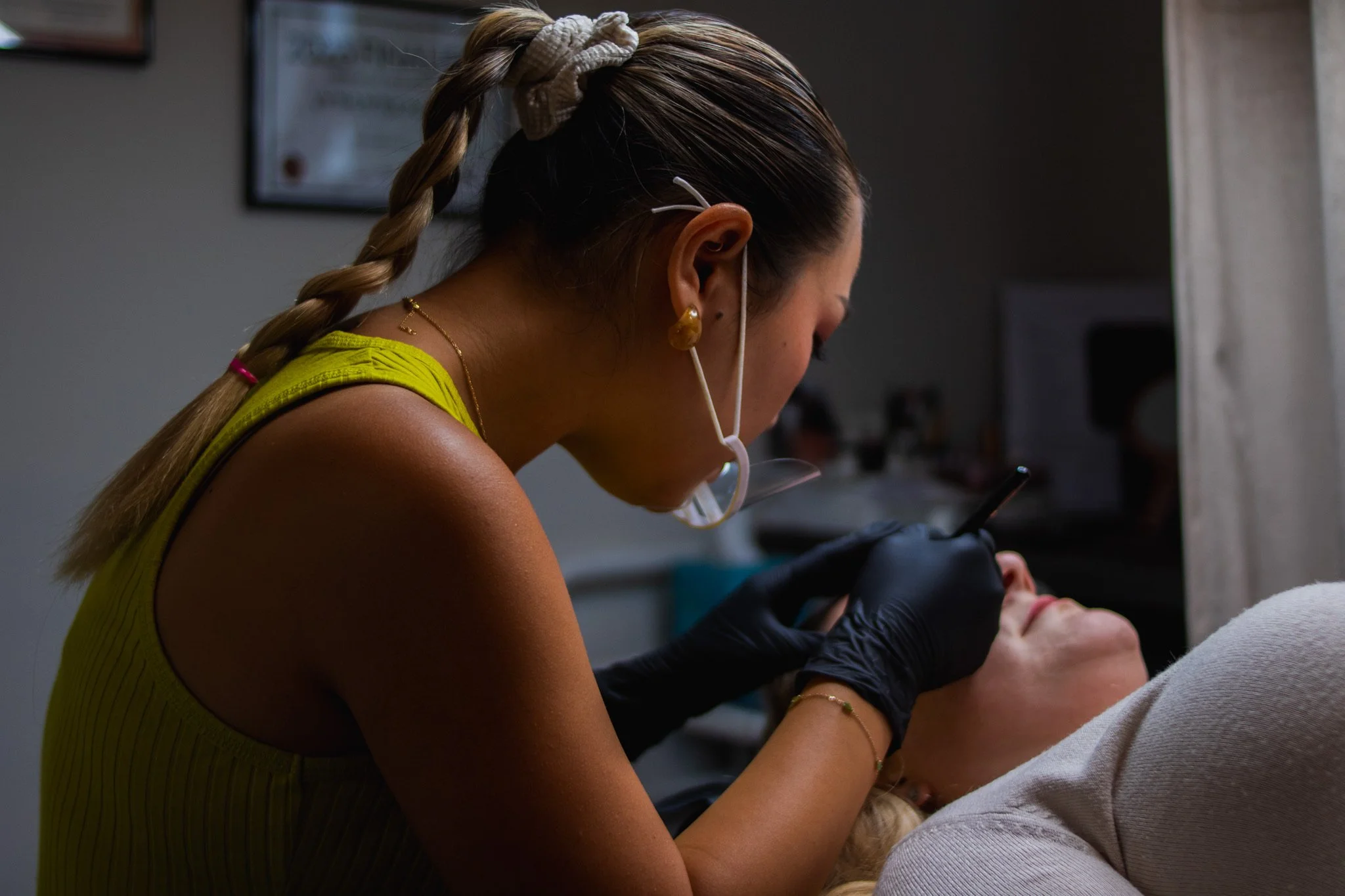What is Saline (Non-laser) Brow Tattoo Removal ?
Saline brow tattoo removal is a non-laser technique that uses a saline solution to remove or lighten cosmetic eyebrow tattoos. It's an alternative to laser removal and is particularly useful for those who have sensitive skin, are allergic to laser treatment, or want a natural removal process.
How The Procedure Works —
Saline brow tattoo removal is a non-laser technique that uses a saline solution to remove or lighten cosmetic eyebrow tattoos. It's an alternative to laser removal and is particularly useful for those who have sensitive skin, are allergic to laser treatment, or want a natural removal process.
-
* A technician applies a saline-based solution to the tattooed area using a tattoo machine or hand tool. This solution typically contains a mix of salt and other natural ingredients.
* The solution penetrates the skin, binds to the tattoo pigments, and lifts the ink to the surface of the skin through the natural healing process.
* Over time, as the treated area heals, the ink is expelled through scabs that form on the skin.
-
Just like with laser removal, multiple sessions are needed depending on the depth of the tattoo, the type of ink used, and the size of the area.
Lighter tattoos or those done more recently may require fewer sessions, while older or darker tattoos may take longer to fade.
-
Saline removal works on all skin tones and types, as it doesn’t rely on laser technology that can sometimes affect darker skin more harshly.
It’s also effective on all ink colours, unlike laser removal, which can struggle with certain pigments like white or yellow.
Non Laser (Saline) Pre Care
Preparing for laser tattoo removal involves several steps to ensure your skin is in the best condition for the treatment and to reduce any potential risks. Here’s what you should consider before your appointment:
1. Avoid Sun Exposure
* Keep the tattooed area out of direct sunlight for at least 4 weeks before treatment. Sunburned or tanned skin can increase the risk of complications like hyperpigmentation or blistering.
* If you can’t avoid sun exposure, use a high-SPF sunscreen (50+) on the tattooed area.
2. Stay Hydrated
* Drink plenty of water in the days leading up to the treatment to keep your skin hydrated and aid in healing after the session.
3. Avoid Blood Thinners
* Refrain from taking medications like aspirin, ibuprofen, or other blood-thinning substances for about 48 hours before your appointment. These can increase the risk of bruising and bleeding during the procedure
* Consult your doctor if you’re on prescription blood thinners.
4. No Alcohol or Smoking
* Avoid alcohol for at least 24 hours before your appointment, as it can thin your blood and affect healing.
* Smoking can impair your body’s ability to heal, so it’s recommended to reduce or stop smoking a few weeks prior to treatment.
5. Avoid Skincare Products
* Refrain from applying lotions, creams, or perfumes to the tattooed area on the day of treatment. Your skin should be clean and dry.
6. Consult with Your Technician
* Ensure you’ve had a consultation with your practitioner to discuss your medical history, any allergies, and potential risks or side effects. This will help them tailor the treatment to your needs.
By following these steps, you can prepare your body and skin for laser tattoo removal and optimise the results while minimising complications.
Non Laser (Saline) After-Care
To ensure the best results and minimise any risks, please follow the aftercare instructions provided below. Adherence to these guidelines is crucial to avoid complications such as infection or scarring.
Aftercare Instructions:
Initial Healing Period:
Your skin will take approximately 24 hours to establish a protective barrier. During this time, avoid touching the treated area to prevent introducing infection. Keep the area clean and dry.
Post-Procedure Observations:
You may observe the following responses, which are common and temporary:
Frosting: White, raised vapour bubbles on the skin that will gradually subside.
Pinprick Bleeding: Tiny spots of bleeding at the treatment site.
Elevation: The treated area may be raised.
Redness: The area around the treated site may be red (erythema).
Itching: Mild itching in the treated area.
Bruising: Possible bruising around the treated site.
Blistering: Blisters may form; this is not an indication of scarring.
Micro-Scab Formation: A micro-scab may form approximately 5 days post-procedure. Allow it to shed naturally without picking.
Care Recommendations:
Cooling and Soothing: Use cool packs to alleviate redness and swelling, but avoid excessive touching.
Dry Healing: The best approach is to ‘dry heal’—avoid using creams or gels unless provided by us.
Important Notes:
Avoid Picking: Scarring often results from picking at the wound or micro-scab or from introducing infection by touching the site. Please refrain from touching or picking the area.
Sun Protection: For 6 weeks post-procedure, keep the treated area protected from sunlight. If exposed, use a sunscreen with a minimum SPF of 30.
Pigmentation Changes: You may notice temporary changes in skin colour:
Hypopigmentation: Lighter skin around the treated area, which usually resolves over time.
Hyperpigmentation: Darker skin around the treated area, which typically resolves over time.
Texture Changes: Any changes in skin texture are likely due to the original tattoo rather than the removal process.
Cover-Up Tattoos: Wait at least 8 weeks for the dermis to fully heal before getting a cover-up tattoo on the treated area.
If You Have Concerns:
For any concerns or questions regarding your removal procedure, please contact me directly for advice or reassurance.
If you suspect an infection or feel unwell after the procedure, contact your GP immediately and inform me as soon as possible.

